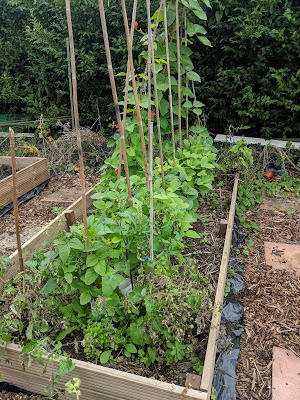I love them, the kids love them, everyone loves them! They're a superb source of protein and also calcium, so for a dairy free (almost) household we eat a lot of them. When I took on the allotment I knew I wanted to grow them. Not because it would save us money... because I've never seen how they grow and I wanted to get them in the ground.
How to Grow Edamame (soya) Beans
Edamame need a long growing season. The need to be started off indoors at the end of May, hardened off and then planted out in July. Their growing position needs to be full sun in moist, well draining soil with plenty of nutrients. Very similar to runner beans. They do climb but some are self supporting, I put mine around canes just to help lighten their load when fruiting. Space them around 30 cm apart as they can get quite bushy and can grow up to 1m tall.
They seem to be very slow growing but will burst into life around August with tiny white flowers where the seed pods will form. The pods grow in large bunches hidden under the leaves so you may not notice them until you get up close and look for them!
 How to Harvest Edamame (soya) beans
How to Harvest Edamame (soya) beansAs the pods start to swell they'll need feeding to ensure good growth of the beans. I used a diluted seaweed extract once a week through August and the beginning of September to help them along.
The harvesting period of Edamame is very short indeed, ideally with the whole crop harvested in one go. You want to get them before the leaves of the main plant start to yellow and when the pods are still bright green and firm. They'll need inspection every few days in the run up to harvesting to ensure they're picked at their prime. Yellowing pods and leaves signal that their nutrients are diminishing so you want to pick them before they get to this stage.
To harvest, simply cut the whole stem off at ground level, find somewhere comfortable to sit and pluck the green pods off. Cut up and compost the leaves and stems. Leave the roots in the ground for a few weeks to add extra nitrogen back to the soil.
 How to eat or store Edamame (soya) beans
How to eat or store Edamame (soya) beansOnce the beautiful green pods have been picked, you'll want to either eat them or store them. They will keep in a refrigerator for up to a week after being harvested but are always best when fresh.
The beans HAVE TO BE COOKED before consumption so don't be tempted to eat them like peas. At least 10 minutes boiling time will get rid of any toxins in the beans. They can be boiled in their pods and them popped out and straight into your mouth as a snack. A little salt and dried chilli is a delicious addition. Just don't eat the outer pod!
If you'd like to store them, they freeze well as long as they're blanched first. Add the whole pods to boiling salted water and cook for 1 minute. remove from the heat and immerse immediately in ice water to stop them cooking further. Now you can freeze them in the pods as they are OR you can shell them, spread them on a baking tray and freeze. Freezing on a tray stops them clumping together. Once they're frozen put them in a Tupperware box with a lid. They'll keep for at least 6 months, but they never last that long in our house!
Have you grown soya beans this year? How was your harvest?
















